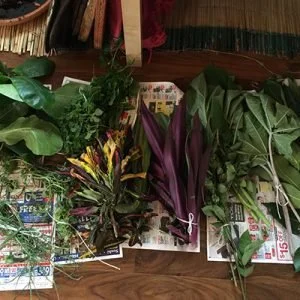Isefa - What is a Hand of Ifa?
Isefa, or Receiving One Hand of Ifa, is a ritual (ceremony) marking a major milestone in the Ifa / Orisa journey. Isefa is long-known to help devotees develop spiritual intimacy with their Ifa and Ori inu (inner head), as well as help them navigate through life with heightened, greater tranquility.
So what is a “Hand” of Ifa, anyway?
Isefa is called one Hand of Ifa because it is a precursor step to full Ifa Initiation (Tefa), where one would receive the second and subsequent “Hands” (sets) of Ifa. A “Hand” of Ifa is a complete set of Ikin (sacred palm seeds) making up the consecrated Ifa. In other lineages and cultures that practice Ifa, it can be known as Awofakan, Kofa, Icofa/Ikofa, Mano de Orula, or other names. For the purposes of this writing, we focus on the more traditional West African ceremony. The performance of Isefa is between 1 to 3 days, depending upon the lineage and its respective priests.
During this ceremony, one receives their first set of Ikin. In our temple, when working in a three-day ceremony, we dedicate the first day of the ceremony to propitiating ones blood ancestors, feeding Esu (whether receiving him or not), appeasing and venerating Egbe (the deity and matrix dealing with one’s astral mates or spiritual companions), and washing and feeding one’s Ori (known as Ori Bibo). With this Ori Bibo, one might take home an herbal bath made that day or bathe with some prepared spiritual soap, depending on circumstances. Lastly of course the new Ifa is consecrated, and other ritual aspects may occur, depending upon the need of the individual as directed by divination.
The second day of a three-day ceremony is held as a “rest” day- with orientation time placed aside to introduce obi divination or other important material. Afterall, day one was hefty. If any ceremonial aspects were unable to be completed on the first day, they can be finished during this time as well.
The third day of the ceremony, an odu is divined for you that will give you a detailed look into the energies and spirits at work in your life, and some clues as to your destiny. Additionally, the eleke and ide (necklace and bracelet in green and brown) of Ifa will be given to you.
The ceremony can also be condensed and completed in one day, just as effectively, starting with an opening of the way, light propitation to one or more Orisas, and ending with the divination for the odu for this person receiving their Hand of Ifa.
The reception of this odu is not the same as the reception of your life odu during full Ifa initiation (Tefa or Itelodu), however it is an important step and highly useful even if full initiation into the priesthood as an Iyanifa or Babalawo is not something you wish to do. In many lineages the odu spoken and cast in divination during this ritual gives valuable information and Ase or spiritual assistance as you progress along your spiritual path.
For those born into an Ifa or Orisa practicing family, a similar ceremony called Esentaye (first steps upon the Earth) occurs for a newborn child within the first week of its life. This ceremony is given to see the spiritual imprint, as it were, related to the quality of the newborn child’s birth and incarnation upon the Earth. The child grows up with some early knowledge about their destiny as well as related taboos so as to have a fulfilled life as they are growing up. Of course, for the rest of us, the Hand of Ifa is usually our first introduction to such concepts, acting as a formal check-in for one’s destiny in general.
Here’s an important question right now :
Can someone receive a Hand of Ifa long distance?
And the answer is emphatically yes.
It is not just Western Babalawos doing so either; many priests offer and perform this ritual for students living abroad in absentia and then mail their shrines to them and instruct them on how to set up the shrine in their homes after receiving. It has long been a common and accepted practice to consecrate a hand of Ifa for a person without them present, though with their consent, with the same efficacy. Thanks to technology like video conferencing that is always improving, we are able to worship and exchange easily, leading to much more fulfilled practices for devotees.
If you’ve had an interest in a personal Ifa practice, or have known for years that you needed to receive your Hand of Ifa, feel free to reach out to us and we would be happy to assist you in beginning your journey with Ifa. In my role as His Spiritual Majesty Oba (The King of Orisa) in North America, I have had the distinct honor and privilege of facilitating the Isefa ceremony for over 300 devotees and worshippers worldwide. Folks from all backgrounds of life, educations, careers and various interests have greatly benefited from the blessings brought about in their lives with this important step in their spiritual journey.
Update: December 25, 2022
Isefa and basic Ifa practice is such an important and nuanced topic, that we wrote a 256 page book on it - a practical and step by step guide written with both beginners and the experienced students in mind.
Out Now: Practical Foundations of Ifa
A Handbook of Ifa View and Practice
This book answers important questions like:
How do I take care of my Ifa, or make offerings?
How do I know what Ifa (or my Ori, or my ancestors) wants from me?
When should I pray, and how?
and so much more…



